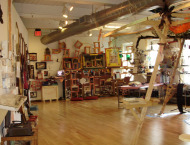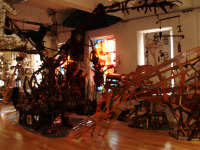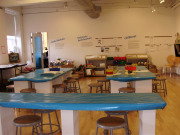While at MASS MoCA last Saturday, I stopped in at the new Kidspace, a nine-year-old collaboration with the Sterling and Francine Clark Art Institute and the Williams College Museum of Art that moved to new premises in late March. On view is CRIBS by
 Matthew Bua, an installation that features a crib crammed with detritus, found paintings, vacation slides, gloves, and 50 guitars rescued from the streets of New York, and other junk.
Matthew Bua, an installation that features a crib crammed with detritus, found paintings, vacation slides, gloves, and 50 guitars rescued from the streets of New York, and other junk.
But there were no kids in Kidspace when I was there — just two adult attendants. Working against Kidspace, perhaps, was the warm, sunny day. And it was lunchtime.
Still I was curious about the Kidspace experience, so in the last few days I’ve been querying MASS MoCA, which said my visit occurred at a typically downtime for museums in the Berkshires. From end-June through the summer, MASS MoCA says, Kidspace will be “incredibly busy” with public hours every day and art classes three days a week.
Just what I wanted to hear to start a new, irregular feature on Real Clear Arts called Five Questions. Laura Thompson, the Director of Exhibitions and Education for Kidspace, stepped up to the plate this time.
What is artist Matthew Bua trying to convey to the kids?
 Matt is trying to convey that 1. collections don’t have to be hidden away or made precious; they can be used to tell a story about a person or place, or can be incorporated into artwork; 2. he is of the “use it or lose it” mindset, which means he believes collection materials and recyclables should be used for artistic endeavors; and 3. architecture can be produced by anyone and should have more unique individual characteristics.
Matt is trying to convey that 1. collections don’t have to be hidden away or made precious; they can be used to tell a story about a person or place, or can be incorporated into artwork; 2. he is of the “use it or lose it” mindset, which means he believes collection materials and recyclables should be used for artistic endeavors; and 3. architecture can be produced by anyone and should have more unique individual characteristics.
[As for MASS MoCA,] we are hoping to spark discussions on aesthetics such as: what is art, does it have to be beautiful, and how could they make something like this in their own lives? Following viewing the installation, Kidspace always has an art-making opportunity, and for CRIBS, we are making “junk-itecture” – architectural sculpture out of found objects and recyclables.
Aside from organized school programs, does this Kidspace effort get many walk-in visitors and by what age group?
In our previous space on the third floor, we would get about 13,000 annual walk-in visitors who participated in our public hours and art classes. We work with about 1,100 school children annually, both in Kidspace and in their own classrooms (often with artists-in-residence). Since moving Kidspace to the 2nd floor, adjacent [to Sol] LeWitt[‘s installation], we’ve seen about a 40% increase in walk-in traffic, so we project next year’s number will be about 18,000 visits during public hours.
The public age ranges from birth to senior citizens, but mostly I would say families with children ages 3 to 16.
For a museum in a city of 15,000 with a population base of only about 100,000 in the Berkshires, our public visitation is very strong.
How do children react to this installation? Do they explore it or just look at it?
Many children first express delight at seeing so many interesting things and that they can touch or open (boxes and cases). The older kids compared him to Tim Burton and several said “I bet this is how he started making his work, and now he is my favorite director.” Many said wished their room looked like this, god forbid. An elementary student said “I like that it looks like he didn’t follow any rules.” Our after-school program for teenage girls named Matt “their hero” because of his freedom in expression.
What proportion of visitors actually make art there?
 Most everyone makes art in Kidspace, even those who come without children. Some visitors have stayed 3 to 4 hours working on art projects, over which they discuss the CRIBS exhibit, as well as process what they viewed in the main galleries. Comments visitors have made about CRIBS have been positive for the most part. Visitors come to expect that we will challenge their notions of art and offer interesting art-making projects (not crafts).
Most everyone makes art in Kidspace, even those who come without children. Some visitors have stayed 3 to 4 hours working on art projects, over which they discuss the CRIBS exhibit, as well as process what they viewed in the main galleries. Comments visitors have made about CRIBS have been positive for the most part. Visitors come to expect that we will challenge their notions of art and offer interesting art-making projects (not crafts).
What has MASS MoCA learned about the use, and value, of Kidspace that it can share with museums, parents, artists and educators?
Anecdotal evidence suggests that children are more skilled at problem solving and communicating their opinions when they are engaged in multiple visits to museums and artist residencies. Writing skills are demonstrably improved. Ability to speak articulately about art — even abstract art — is night and day between students who have gone through the Kidspace curriculum.
Especially with schools that are struggling to improve MCAS test scores, we have found that art education can help to alleviate some of the stress that children and teachers feel as a result of the testing pressures.
Educators and parents have noted that their children feel Kidspace is “their space.” It is not uncommon to see joyfully determined children walking confidently through the museum’s lobby with initially reluctant parents in tow. Remember, this is a deep commitment, so by the time students are 6th graders, they have made over a dozen visits, each with 20 or 30 hours of curricular study materials…so they know the place inside and out.
We are hoping to sometime in the future offer a summer institute for educators that would focus on everything that we have learned about collaborations with entire schools and contemporary art education.
You can find out more about Kidspace here.
